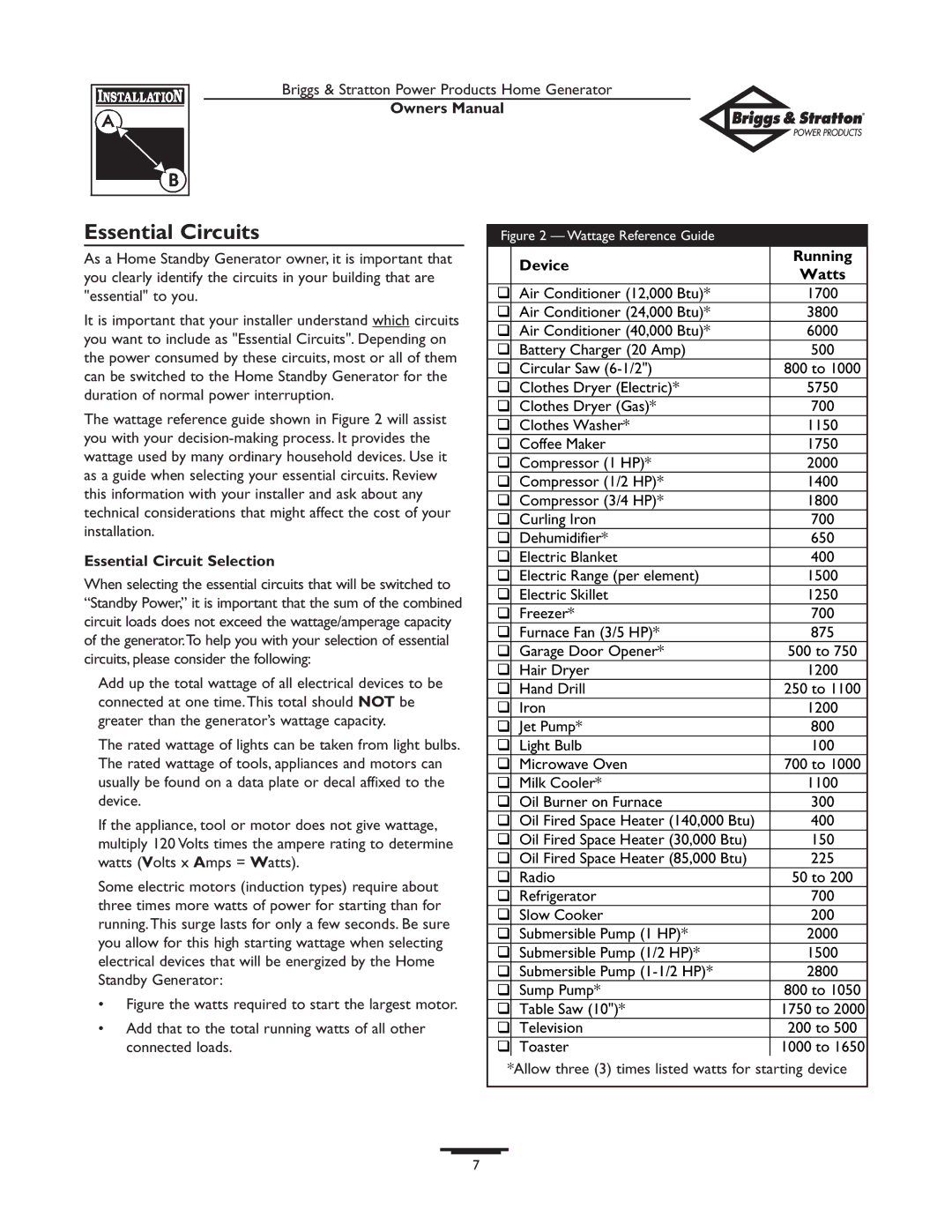
Briggs & Stratton Power Products Home Generator
Owners Manual
Essential Circuits
As a Home Standby Generator owner, it is important that you clearly identify the circuits in your building that are "essential" to you.
It is important that your installer understand which circuits you want to include as "Essential Circuits". Depending on the power consumed by these circuits, most or all of them can be switched to the Home Standby Generator for the duration of normal power interruption.
The wattage reference guide shown in Figure 2 will assist you with your
Essential Circuit Selection
When selecting the essential circuits that will be switched to “Standby Power,” it is important that the sum of the combined circuit loads does not exceed the wattage/amperage capacity of the generator.To help you with your selection of essential circuits, please consider the following:
Add up the total wattage of all electrical devices to be connected at one time.This total should NOT be greater than the generator’s wattage capacity.
The rated wattage of lights can be taken from light bulbs. The rated wattage of tools, appliances and motors can usually be found on a data plate or decal affixed to the device.
If the appliance, tool or motor does not give wattage, multiply 120 Volts times the ampere rating to determine watts (Volts x Amps = Watts).
Some electric motors (induction types) require about three times more watts of power for starting than for running.This surge lasts for only a few seconds. Be sure you allow for this high starting wattage when selecting electrical devices that will be energized by the Home Standby Generator:
•Figure the watts required to start the largest motor.
•Add that to the total running watts of all other connected loads.
Figure 2 — Wattage Reference Guide
| Device | Running |
| Watts | |
|
| |
| Air Conditioner (12,000 Btu)* | 1700 |
| Air Conditioner (24,000 Btu)* | 3800 |
| Air Conditioner (40,000 Btu)* | 6000 |
| Battery Charger (20 Amp) | 500 |
| Circular Saw | 800 to 1000 |
| Clothes Dryer (Electric)* | 5750 |
| Clothes Dryer (Gas)* | 700 |
| Clothes Washer* | 1150 |
| Coffee Maker | 1750 |
| Compressor (1 HP)* | 2000 |
| Compressor (1/2 HP)* | 1400 |
| Compressor (3/4 HP)* | 1800 |
| Curling Iron | 700 |
| Dehumidifier* | 650 |
| Electric Blanket | 400 |
| Electric Range (per element) | 1500 |
| Electric Skillet | 1250 |
| Freezer* | 700 |
| Furnace Fan (3/5 HP)* | 875 |
| Garage Door Opener* | 500 to 750 |
| Hair Dryer | 1200 |
| Hand Drill | 250 to 1100 |
| Iron | 1200 |
| Jet Pump* | 800 |
| Light Bulb | 100 |
| Microwave Oven | 700 to 1000 |
| Milk Cooler* | 1100 |
| Oil Burner on Furnace | 300 |
| Oil Fired Space Heater (140,000 Btu) | 400 |
| Oil Fired Space Heater (30,000 Btu) | 150 |
| Oil Fired Space Heater (85,000 Btu) | 225 |
| Radio | 50 to 200 |
| Refrigerator | 700 |
| Slow Cooker | 200 |
| Submersible Pump (1 HP)* | 2000 |
| Submersible Pump (1/2 HP)* | 1500 |
| Submersible Pump | 2800 |
| Sump Pump* | 800 to 1050 |
| Table Saw (10")* | 1750 to 2000 |
| Television | 200 to 500 |
| Toaster | 1000 to 1650 |
*Allow three (3) times listed watts for starting device
7
